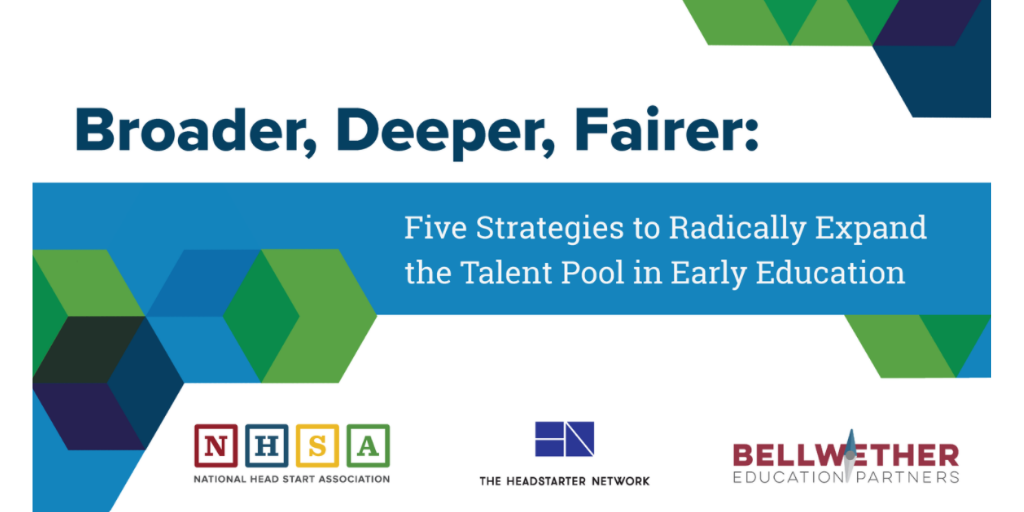New White Paper Identifies Strategies to Expand the Early Learning Talent Pool

In January, Bellwether Education Partners, the National Head Start Association, and the HeadStarter Network released its new white paper, Broader, Deeper, Fairer: Five Strategies to Radically Expand the Talent Pool in Early Education. The paper comes at a critical moment in which the pandemic has demonstrated that the early childhood workforce is a linchpin for our immediate economic recovery, as well as for a stronger future. A teacher’s education and training is crucial to the quality of an early learning classroom, but existing preparation and ongoing training often fails early educators, leaving them to figure out on their own how to effectively work with children, without the resources or support to do so. To ensure all children have access to affordable, comprehensive, high-quality care and education, early educator preparation must be improved.
The white paper identifies tools to do just that, enhancing the overall quality of training, while also making it more practical, accessible, and inclusive. To be effective, these reforms must champion equity, involve educators, pay fairly, credit experience, and account for participant’s real-life circumstances. The five strategies are as follows:
- Redefine Credentials
- Rethink Degree Attainment
- Optimize Practice-Based Training (including early childhood apprenticeships)
- Expand Job-Embedded Coaching
- Connect In-Service Preparation to Career Advancement
Background
To begin, the white paper summarizes the current paths for early childhood workforce preparation: formal coursework in pursuit of a degree, typically sought as pre-service preparation; practice-based training, which often accompanies or follows formal coursework; and in-service professional learning, which occur after educators enter the classroom and may consist of coaching and mentoring or workshops and conferences.
This preparation is essential to an educator’s success, and as such it is increasingly required, but these requirements come with little financial incentive or support. Attaining a credential or degree is expensive and time consuming, however, compensation is unlikely to match or reward this significant investment. For those already teaching, it may be financially and logistically impossible to leave the classroom to pursue a credential or degree. The five strategies identified in the white paper seek to break down some of these barriers to recruit, develop, and retain highly-qualified teachers.
The Five Strategies
The white paper provides background for each of the strategies and explains how it drives effective preparation across industries and in education. With this context, the paper analyzes one promising strategy, recommends steps for moving forward, and gives an example of a comparable strategy in practice.
The first strategy, Redefine Credentials, looks at ways to leverage and build on the Child Development Associate credential (CDA), an entry-level credential designed for early educators. More than 20 states’ early educator requirements include a CDA, and individuals with a CDA can qualify as Head Start assistant teachers and Early Head Start teachers. Specifically, the strategy calls for the development of: 1) a national repository for all CDA credential training options, including which programs will result in college credit; and 2) a second national credential that layers on the CDA and is seen as equivalent to a four-year degree.
The second strategy, Rethink Degree Attainment, imagines the creation of an online, accredited, and degree-granting institution of higher education (IHE) designed specifically for current and prospective early educators, which would promote access to an affordable, accessible, and rigorous early learning training program. Similarly, strategy three, Optimize Practice-Based Training, seeks to remove barriers to credential or degree completion by elevating early childhood apprenticeship programs, which offer “earn while you learn” opportunities to individuals, while also allowing providers to improve the quality and effectiveness of their staff.
Strategies four and five focus on training for educators already in the classroom. Strategy four, Expand Job-Embedded Coaching, proposes partnerships with an IHE to implement a credit-bearing coaching model that gives educators course credit for working with their coach, which could be applied towards a credential or degree. The fifth strategy, Connect In-Service Preparation to Career Advancement, incentivizes ongoing training by providing opportunities for career advancement, to work in other settings, or to specialize in an area of instruction, which would confer recognition, professional status, and compensation, while also allowing educators to remain in the classroom. Advancement opportunities might include serving as a mentor teacher, instructional specialist, or school leader, and the white paper proposes the creation of rotation or fellowship programs that would provide the chance to develop new perspectives and expertise.
Since February 2020, the child care industry has lost more than 170,000 jobs that still have not been recovered. This white paper provides innovative and timely strategies to build back a highly-qualified workforce, which is essential to providing high-quality early learning and care opportunities. Read the full white paper here.
Subscribe to FFYF First Look
Every morning, FFYF reports on the latest child care & early learning news from across the country. Subscribe and take 5 minutes to know what's happening in early childhood education.



